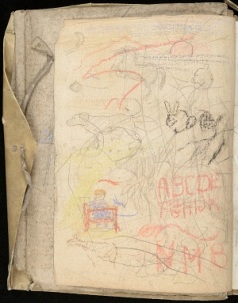Excavating Bloomsbury – The Angelica Garnett Gift and the Archaeological Imagination
Last week on the first day of Charleston’s 2015 opening, curatorial trainee Dorian Knight presented his research on the Angelica Garnett Gift. He focused on how this archive in its entirety can be analysed using the approaches of an archaeologist, with the intention of yielding a new and original interpretation.
This was done by thinking about ruins, a theme of obvious concern to archaeologists. If we consider an ancient temple that has fallen into ruin, our attention is first drawn to the picturesque processes of material decay, ivy and moss growing into crumbling stone. This ruination is parallel to the state of the Angelica Garnett Gift; prior to its cataloguing the Gift was raw, unprocessed and unconserved, with stranded and fragmented pages of all sizes, ages and materials, grouped together en masse as seen below, items occasionally wrapped around one another, materials smudging. Thinking of the Gift in this way draws attention to the materiality of the objects as they undergo ruination, which can lead to a number of speculations about their character and aesthetics.
One of these speculations is the importance of the medium itself; although it is the artistic content of the Angelica Garnett Gift that may garner the most interest, I believe thinking as an archaeologist highlights the importance of these pieces not just as art works, but as artefacts, to be felt, touched and sensed; because to engage with the sensory, tactile and corporeal nature of the Gift is to appreciate it on a profound level that forces us to pay attention to the physical textures of the Bloomsbury world.






















